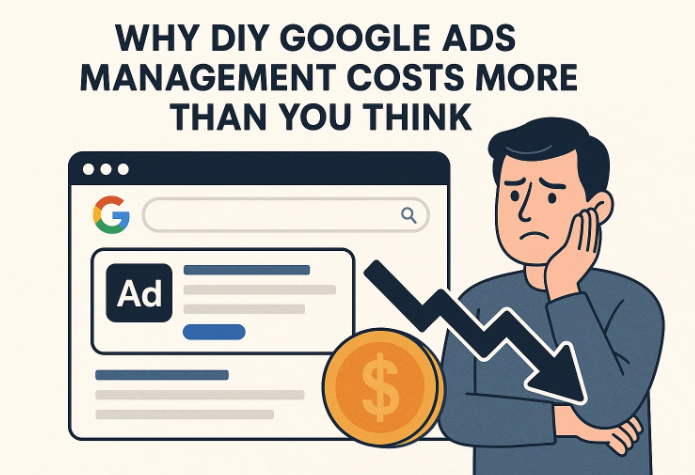Last week, a software company founder told me he’d been managing his own campaigns for eight months. He’d watched dozens of YouTube tutorials, read countless blog posts, and spent about 10-15 hours weekly trying to optimize his ads. When I asked about results, he admitted the campaigns barely broke even. The real kicker? He calculated that those hours cost his business over ₹8 lakhs in opportunity cost—time he should’ve spent closing deals and building his product instead.
This pattern repeats itself constantly. Business owners think they’re saving money by handling advertising themselves, not realizing the hidden costs are destroying their profitability.
The Time Investment Nobody Talks About
Here’s what most people don’t realize: properly managing campaigns requires substantial ongoing time investment that scales with budget and complexity. Small accounts spending ₹50,000-₹2 lakhs monthly need roughly 2-3 hours weekly just for basic maintenance, plus additional time for strategy and reporting. Medium accounts at ₹2-8 lakhs monthly require 5-10 hours weekly. Larger accounts above ₹8 lakhs demand 15-20 hours weekly of detailed analysis and optimization.
That’s not including the initial setup, which takes 5-10 hours just getting everything configured correctly. Then there’s the learning phase where campaigns need constant monitoring as algorithms gather data and optimize delivery. This learning period typically lasts 1-4 weeks after launch or any significant changes, and performance can be volatile during this time.
The expertise gap makes everything take longer too. What experienced professionals complete in 30 minutes might take someone still learning 3-4 hours. Tasks like keyword research, ad copywriting, landing page optimization, conversion tracking setup, audience segmentation, and bid management each require specialized knowledge that takes months to develop properly.
Research shows going from complete beginner to basic competence takes 4-6 weeks of focused learning. Getting from novice to experienced takes 6-12 months of hands-on practice. Reaching true mastery requires 100+ hours of dedicated study and practical application. Most business owners simply don’t have that kind of time to invest while also running their companies.
The platform keeps changing too, forcing you to constantly relearn things. Google makes over 3,200 algorithm updates annually—averaging nine changes daily. Some are minor tweaks nobody notices, but major updates can dramatically shift what works overnight. Unless you’re monitoring industry news and testing new features continuously, you’ll fall behind competitors who stay current.
The Costly Mistakes That Happen When You Wing It
DIY marketing creates a trial-and-error situation where every mistake costs real money. Without professional guidance, businesses consistently make expensive errors—wrong audience targeting, ineffective ad copy, poor landing page experiences, and misallocated budgets that drain accounts without generating returns.
The financial impact extends beyond wasted ad spend too. Poor campaign performance means lost revenue from customers who went to competitors instead. Inconsistent messaging damages brand reputation and confuses potential customers, making future marketing efforts less effective. Amateur efforts often achieve poor ROI that makes advertising seem unprofitable, when really the problem is execution quality.
Consider the opportunity cost calculation. If you’re spending 10 hours weekly managing campaigns that could be handled by professionals, and your time is worth ₹5,000 per hour based on your business’s revenue generation, that’s ₹50,000 weekly or ₹2.6 lakhs monthly in opportunity cost. You’re paying yourself less than you’d pay professionals, but doing lower quality work that produces worse results.
The learning curve creates additional hidden costs. While figuring out what works through trial and error, you’re burning budget on experiments that professionals already know won’t succeed. That ₹50,000 wasted testing a bidding strategy that never works could’ve gone toward profitable campaigns from day one if managed by experts.
Industry data shows businesses routinely waste 20-40% of their advertising budgets through inefficiencies that proper management would prevent. On a ₹1 lakh monthly budget, that’s ₹20,000-₹40,000 evaporating each month—₹4.8 lakhs annually—just from avoidable mistakes. Over three years, that’s ₹14.4 lakhs that could’ve driven business growth instead.
The Increasing Complexity of Digital Advertising
The advertising landscape has become dramatically more complicated in recent years, making DIY approaches less viable than ever. Global digital ad spending reached $843 billion in 2025 and is projected to hit $1.42 trillion by 2029. As the industry grows, competition intensifies and platforms become more sophisticated.
Nearly 80% of marketers report that spreadsheets remain critical for their work—a sign that managing multiple platforms and campaigns has become overwhelmingly complex. Media and audience fragmentation is cited by 44% of marketers as a top concern for 2025, up 9 percentage points from the previous year. The abundance of channels—search, social media, display, video, retail media networks, CTV platforms—creates coordination challenges that drain efficiency.
Only 2% of marketers say they’re satisfied with their current technology stacks. Fragmented systems lead to duplicated efforts, inconsistent metrics, and chaotic planning processes. Even basic tasks like translating campaign briefs across ten different publishers can consume hours or days.
The rise of AI has added another layer of complexity. While AI tools offer powerful optimization capabilities, they also change how advertising works fundamentally. AI-generated search results now occupy top positions that used to show sponsored ads, pushing traditional placements down the page and reducing visibility. Marketers need to adapt strategies constantly to stay effective in this shifting environment.
India specifically faces rapid transformation in advertising, with ad expenditure projected to grow at 10.5% CAGR reaching ₹1.25 trillion by 2025. Digital advertising now accounts for over 50% of total spend, driven by smartphone penetration and affordable internet. Hyper-localization and AI-driven personalization have become essential, requiring sophisticated approaches most small businesses can’t execute alone.
Why Professional Management Makes Financial Sense
This is where working with a google ads agency transforms from an expense into an investment that pays for itself through improved results and reclaimed time. Professionals bring expertise developed across hundreds of campaigns, so they avoid the costly mistakes that plague DIY efforts.
They also work faster and more efficiently than someone still learning. Tasks that would take a business owner 5 hours get completed by experts in 30 minutes. Campaign setup that might take a beginner 10-15 hours of frustration gets handled properly in a few hours by experienced managers. This efficiency alone justifies the investment—you’re getting far more work completed in less time.
The continuous optimization piece is where agencies really prove their value. They monitor performance daily, identify opportunities and problems immediately, and make adjustments before budget gets wasted. They stay current with platform changes, algorithm updates, and industry best practices without you having to spend time learning these things. They implement advanced strategies like audience segmentation, remarketing, cross-platform attribution, and conversion optimization that require specialized expertise.
Budget efficiency improvements often cover management fees entirely. If an agency reduces wasted spend by 25% through better targeting and optimization, that savings on a ₹1 lakh monthly budget equals ₹25,000—which likely exceeds the management fee. Meanwhile, you’re getting better results from the remaining 75% because it’s allocated more effectively. The improved performance typically generates 2-3x returns compared to DIY efforts, meaning you’re making significantly more revenue from the same investment.
The opportunity cost reclamation matters enormously too. Those 10-15 hours weekly you were spending on advertising get freed up for activities that actually leverage your expertise—closing sales, developing products, building partnerships, serving customers. If redirecting that time toward revenue-generating activities brings in even one extra customer monthly, the financial impact dwarfs any management fees you’re paying.
The Real Cost of Staying Behind Competitors
Here’s the uncomfortable truth: while you’re struggling to figure out advertising basics, competitors working with professionals are capturing customers you should’ve won. The digital marketplace grows more competitive daily, with market saturation ranking as the top challenge for small businesses even above limited budgets.
Small businesses consistently cite lead generation and budget constraints as their biggest marketing challenges. The DIY approach makes both problems worse—you’re burning limited budget inefficiently while failing to generate quality leads because campaigns aren’t optimized properly. Meanwhile, businesses that partnered with experts solved both issues through effective management that maximizes every rupee spent.
The complexity will only increase as technology advances and consumer behaviors shift. Staying competitive requires adapting to trends like mobile-first advertising, video content dominance, AI-powered personalization, and omnichannel coordination. For business owners focused on running their companies, keeping pace with these changes while managing Facebook advertising, search campaigns, and other channels simply isn’t realistic.
Every month spent struggling with DIY campaigns is a month competitors are pulling further ahead. They’re capturing more market share, building stronger brand presence, and growing faster because their advertising actually works. The gap widens continuously until catching up becomes exponentially harder.
Making the Investment That Drives Growth
The question isn’t whether you can handle advertising yourself—technically, anyone can log into the platform and create campaigns. The real question is whether DIY management represents the best use of your time and resources, or whether partnering with a google ads marketing agency delivers better financial outcomes through improved results and reclaimed opportunity.
When you calculate the full cost—time investment, opportunity cost, learning curve expenses, mistakes that waste budget, and revenue lost to competitors—DIY almost always costs more than professional management. The perceived savings evaporate once you account for everything you’re actually paying through inefficiency and underperformance.
Professional management eliminates these hidden costs while delivering better results that drive real business growth. You get expertise that would take months or years to develop yourself, applied immediately to campaigns optimized for your specific goals. You reclaim time for activities that actually leverage your skills and move your business forward. Most importantly, you get advertising that works—generating quality leads and customers at profitable costs per acquisition rather than burning money without clear returns.
The businesses that thrive aren’t necessarily the ones with the biggest budgets—they’re the ones that allocate resources strategically, recognize where they need expertise, and partner with professionals who can deliver results they couldn’t achieve alone. Smart advertising management isn’t an expense that cuts into profits; it’s an investment that multiplies them by transforming campaigns from budget drains into growth engines.














